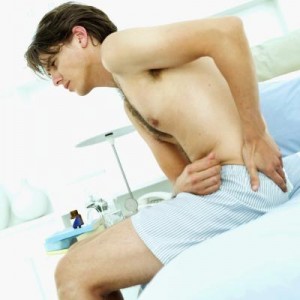
Chronic Pelvic Pain Syndrome, is a chronic inflammation that occurs in the prostate gland which is painful but is not due to a bacterial infection although at the initial onset of pain prostatitis could have been present and properly treated. It is also sometimes referred to as Chronic Non-Bacterial Prostatitis, Category III Chronic Prostatitis, and used to be called Prostatodynia. The prostate is a walnut sized gland in men located below the bladder, surrounds the urethra, and secretes fluid in the semen that protects sperm. Chronic Pelvic Pain Syndrome involves symptoms of pelvic, perineal, or rectal pain, burning, fullness, pressure, painful sitting, and abdominal pain. Patients may complain of pain with urination or urgency, pain at the tip of the penis, painful testicles, or pubic pain. Pain with ejaculation is a distinct complaint. Associated sexual dysfunction such as low libido and erectile dysfunction are also reported as common. Men with Chronic Pelvic Pain Syndrome have pelvic floor muscle dysfunction which many times is the source of the pain. The pelvic floor muscles surround the genitals and anus as a support structure for the organs, help maintain continence, provide lumbo-pelvic stability and aid in erectile function and ejaculation. In CCPS, the pelvic floor muscles may be shortened, in spasm, have myofascial trigger points, and/or tender points. This type of pelvic floor muscle dysfunction is called overactive pelvic floor muscles or hypertonic pelvic floor dysfunction. CPPS can also be related to other musculoskeletal disorders such as osteitis pubis, groin strain, pelvic obliquity, pudendal neuralgia, lumbar spine disorders, and sacroiliac joint dysfunction. Other common related findings are abdominal muscle tender/trigger points, piriformis syndrome, superficial pelvic floor muscle dysfunction, visceral dysfunction, coccyx and hip disorders. Medical treatments for CPPS may include medications/supplements such as NSAIDS (anti-inflammatories), Alpha-blockers, c 5-Alpha reductase inhibitors, phytotherapy (including saw palmetto, bee pollen extract and quercertin), pentosan polysulfate, gabapentin and pregabalin, amitriptyline, opioids, tricyclic antidepressants, and Botox injections into the pelvic floor muscles. Transurethral microwave thermotherapy is another medical treatment available. Long-term antibiotics were the mainstay of treatment until recently. Physical therapy including myofascial release and sEMG pelvic floor muscle biofeedback is considered one of the most effective treatments for CPPS.
How Can Pamela Morrison Physical Therapy, P.C. help with Male Chronic Pelvic Pain?
Our expert pelvic therapists perform a full orthopedic and pelvic floor muscle exam after an extensive history is taken. Importantly, the superficial pelvic floor muscles are closely assessed for tenderness, trigger points, and a full neurological exam of the perineum is performed. Additionally, evaluating for orthopedic issues occurs which consists of posture assessment, range of motion and flexibility tests, special hip/sacroiliac joint orthopedic tests, neurological exam including neural tension testing, strength testing of the legs and core, palpation of all of the spine, hip, and pelvic girdle muscles. Once the diagnosis is confirmed by the therapist’s evaluation, an effective treatment plan is put into place which addresses all of the orthopedic findings and pelvic floor muscle dysfunction. The treatment plan may consist of pelvic floor muscle rehabilitation including sEMG pelvic floor muscle biofeedback, advanced manual therapies, re-education, and electrical stimulation. We also instruct in self massage and relaxation training. Any related associated orthopedic issues may be addressed with advanced manual therapies such as myofascial release, massage, visceral mobilization, joint mobilization, muscle energy techniques, stretching, neuromuscular re-education, neural mobilization, and integrative manual therapy. Bladder and bowel retraining may be addressed. Prescriptive therapeutic exercise is always instructed to the patients during the sessions and included in a home exercise program. Down-training techniques to teach or re-train the pelvic floor muscles to relax are a prime focus. Restoring painfree urination with normal flow rate/volume and sexual function is a key goal. We have great success in treating Male Chronic Pelvic Pain.


